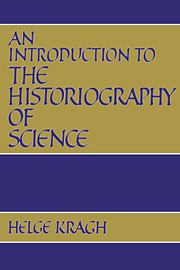Book contents
- Frontmatter
- Contents
- Preface
- 1 Aspects of the development of the history of science
- 2 History of science
- 3 Objectives and justification
- 4 Elements of theory of history
- 5 Objectivity in history
- 6 Explanations
- 7 Hypothetical history
- 8 Structure and organization
- 9 Anachronical and diachronical history of science
- 10 Ideology and myths in the history of science
- 11 Sources
- 12 Evaluation of source materials
- 13 Scientists' histories
- 14 Experimental history of science
- 15 The biographical approach
- 16 Prosopography
- 17 Scientometric historiography
- Notes
- Bibliography
- Index
8 - Structure and organization
Published online by Cambridge University Press: 30 November 2009
- Frontmatter
- Contents
- Preface
- 1 Aspects of the development of the history of science
- 2 History of science
- 3 Objectives and justification
- 4 Elements of theory of history
- 5 Objectivity in history
- 6 Explanations
- 7 Hypothetical history
- 8 Structure and organization
- 9 Anachronical and diachronical history of science
- 10 Ideology and myths in the history of science
- 11 Sources
- 12 Evaluation of source materials
- 13 Scientists' histories
- 14 Experimental history of science
- 15 The biographical approach
- 16 Prosopography
- 17 Scientometric historiography
- Notes
- Bibliography
- Index
Summary
The structural framework of the historian includes, among other things, divisions into historical periods. Obviously, periodization is the work of the historian, not of history. No objective or natural way of dividing up is to be found inbuilt into the historical course of events. This does not mean, however, that all ways of organizing the historical materials are equally good. In the historiography of modern science a tradition has arisen for working with chronological periods that follow the century in question: science in the 20th century, in the 19th, 18th and 17th centuries. The division is obviously arbitrary, in the sense that it does not reflect any internal tendency in the development of science. By chance, it would be reasonable to distinguish between the 19th and 20th centuries in the history of physics, whereas this is not the case in the history of biology or in the history of the earth sciences.
The periods used will normally be chronological so that the development is simply followed through linear time. But one does not have to regard chronologically simultaneous occurrences as being historically simultaneous too. For example, one could decide to place occurrences into periods according to their more or less natural connection in the hope that this would reflect the internal or logical development of science. If so, scientists who were ‘ahead of their time’ may be moved to the chronologically later periods to which they are thought to belong naturally.
- Type
- Chapter
- Information
- An Introduction to the Historiography of Science , pp. 75 - 88Publisher: Cambridge University PressPrint publication year: 1987

